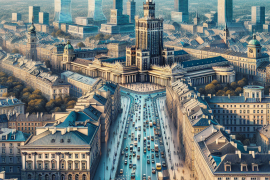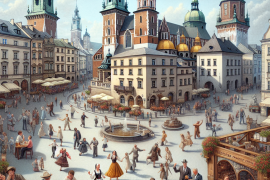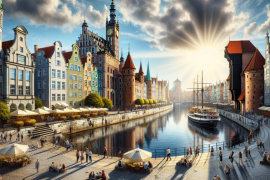
Polish folk art showcases the country’s deep cultural roots through its unique and colorful designs. This art form includes everything from detailed pottery to lively dances and music, reflecting the community’s identity and history. These traditions have stood the test of time and continue to be an essential part of Polish culture.
As we find new ways to keep these practices alive and introduce them at festivals, it raises questions about their place in our modern world. It’s important to talk about how these traditional arts can stay relevant and adapt in our rapidly changing society.
Historical Roots of Polish Folk Art
Polish folk art has deep roots that go back to the ancient Slavic period, showcasing a blend of local creativity and various influences over time. This art form has grown and changed, adapting to the country’s geography, society, and political changes. One of the key strengths of Polish folk art is its ability to take in new cultural elements from outside while keeping its unique character. This shows how folk art acts as a living memory bank and identity marker for the Polish people, reflecting their history and taste in art.
Over the years, Polish folk art has shown remarkable resilience, demonstrating the nation’s strong cultural spirit. For example, the traditional paper-cutting technique, known as Wycinanki, and the colorful, intricate patterns of Polish pottery highlight this adaptability. These art forms have not only preserved traditional methods and motifs but have also embraced new styles and influences, making them popular among collectors worldwide.
The evolution of Polish folk art is a clear indicator of the country’s vibrant culture. It serves as a bridge between the past and present, allowing us to understand the Polish people’s values, traditions, and aesthetics. For those interested in experiencing this rich cultural heritage firsthand, exploring local folk art markets or museums, such as the Ethnographic Museum in Warsaw, can offer a direct window into the heart of Poland’s artistic traditions.
In a more conversational tone, it’s fascinating to see how art can tell the story of a place and its people. Polish folk art is not just about pretty patterns or old techniques; it’s about the stories, struggles, and triumphs of the Polish people. It’s a living history lesson that’s as vibrant and dynamic as the people it represents. Whether you’re an art enthusiast or just curious about Polish culture, diving into the world of Polish folk art is a journey worth taking.
Iconic Forms of Folk Creativity
Poland’s folk creativity is a fascinating area that showcases the country’s rich culture and unique artistic flair. One of the most captivating forms of this creativity is the decoration of eggs, or pisanki. These aren’t just ordinary painted eggs; they carry deep symbolic meanings and are beautiful to look at. The tradition has roots in pagan customs, which were later incorporated into Christian festivities, illustrating a blend of cultural beliefs.
Another remarkable example of Polish folk art is paper cutting, known as wycinanki. This art form turns simple sheets of paper into intricate designs, depicting anything from natural scenes to complex geometric patterns. The precision and imagination involved in creating wycinanki highlight the artists’ skill and creativity.
Wooden sculptures also play a significant role in Polish folk art, telling stories of folklore and everyday life through their forms. These sculptures are more than just decorative items; they are narratives carved in wood, offering insights into the values and traditions of Polish society.
Each of these art forms is a window into Poland’s cultural soul, representing centuries of tradition passed down through generations. They’re not only important for their aesthetic value but also for their role in preserving and sharing Polish culture. For those interested in experiencing these art forms, visiting local markets or folk art galleries in Poland can provide an up-close look at the beauty and craftsmanship of pisanki, wycinanki, and wooden sculptures.
In conversation, discussing Polish folk art can be a way to explore the country’s history and cultural identity. Whether you’re an art enthusiast or simply curious about different cultures, these traditional crafts offer a glimpse into the rich tapestry of Poland’s heritage.
Methods of Preservation
Preserving Polish folk art is essential for maintaining our cultural heritage. This process involves both physical and digital methods to ensure these traditions endure over time. Physically, experts use restoration and conservation techniques to repair and maintain artworks and artifacts. This means fixing any damage and protecting these items from future harm. Museums and cultural organizations also play a crucial role by housing these treasures, making them accessible for everyone to see and appreciate.
Digitally, we keep the essence of Polish folk art alive through detailed documentation. Taking high-quality photos, creating digital archives, and conducting thorough research allows us to capture the stories and knowledge behind each piece. This digital footprint ensures that even if the physical item is lost, its cultural value and significance remain accessible to future generations.
Education is another key element in preserving Polish folk art. By holding workshops and educational programs, we teach younger generations the traditional techniques used in creating these artworks. For example, participants might learn the intricate details of creating Wycinanki, the Polish art of paper cutting, or how to paint in the unique style of Zalipie, a village famous for its decorative floral painted cottages. These hands-on experiences not only keep traditional skills alive but also help in understanding the cultural significance behind each art form.
In essence, preserving Polish folk art requires a comprehensive approach that combines physical care, digital documentation, and education. By engaging with these artworks both in person and online, and learning the traditional crafts themselves, we ensure that these cultural expressions continue to inspire and educate for generations to come.
Festivals and Community Events
Festivals and community events play a crucial role in showcasing and celebrating Polish folk art, bringing people together and strengthening their cultural identity. These events range from cozy village celebrations to grand national festivals, each displaying the diversity of Poland’s cultural heritage through its music, dance, crafts, and food. They do more than just entertain; they keep ancient traditions alive and pass them on to the next generation.
At these festivals, you can see and experience the beauty of Polish culture firsthand. Picture vibrant handwoven fabrics, detailed wooden crafts, and the melodic tunes of folk music filling the air. These elements combine to create a vivid picture of what it means to be Polish.
Think of these festivals as interactive museums. They’re places where both the physical items, like textiles and carvings, and the traditions, like dances and songs, are not just displayed but are part of the experience. You’re not just looking at history; you’re living it. This approach helps ensure that these cultural treasures are not forgotten but are celebrated and preserved within the community.
Let’s dive deeper into what you might find at such a festival. You could come across a stall displaying intricately carved wooden plates, each telling a story of its own. Or you might taste traditional dishes that have been passed down through generations, each bite a lesson in Polish history and family tradition. Listening to a folk band, you’d hear instruments and melodies that have been part of Polish celebrations for centuries.
The Future of Folk Traditions
Festivals and community gatherings are key to keeping Polish folk art alive. However, to ensure these traditions continue for years to come, they must evolve to stay relevant to today’s generation. As our world changes, so too must the ways we preserve culture. This means finding a balance between keeping the original spirit of these traditions and updating them for modern times.
One way to do this is through technology and digital media. These tools can spread Polish folk traditions far and wide, reaching people across the globe. For example, virtual reality experiences could immerse users in Polish festivals, or apps could teach traditional Polish crafts. This not only helps maintain interest in these traditions but also attracts a global audience.
Education also plays a crucial role. By incorporating folk art into school programs, we can spark interest in young people. Imagine art classes where students learn traditional Polish embroidery or music lessons featuring folk songs. This approach not only educates but also instills a sense of pride and responsibility in the younger generation to keep these traditions alive.
Ultimately, the survival of Polish folk traditions depends on our ability to adapt. We must find creative ways to maintain the essence of these practices while making them appealing and accessible to a modern audience. It’s about striking the right balance between respecting the past and embracing the future. By leveraging technology, enhancing education, and engaging communities, we can ensure that these cherished traditions enrich lives for generations to come.
Conclusion
Polish folk art is a key part of Poland’s culture, bringing to life traditions and creativity that have been around for hundreds of years. By keeping these traditions alive through local festivals and educational programs, this unique cultural expression continues to grow.
It’s really important to support these traditions because they help Polish people feel connected to their roots and to each other. Looking ahead, the outlook for Polish folk traditions is positive, as long as we keep celebrating and preserving this important part of our heritage.






Comments are closed.